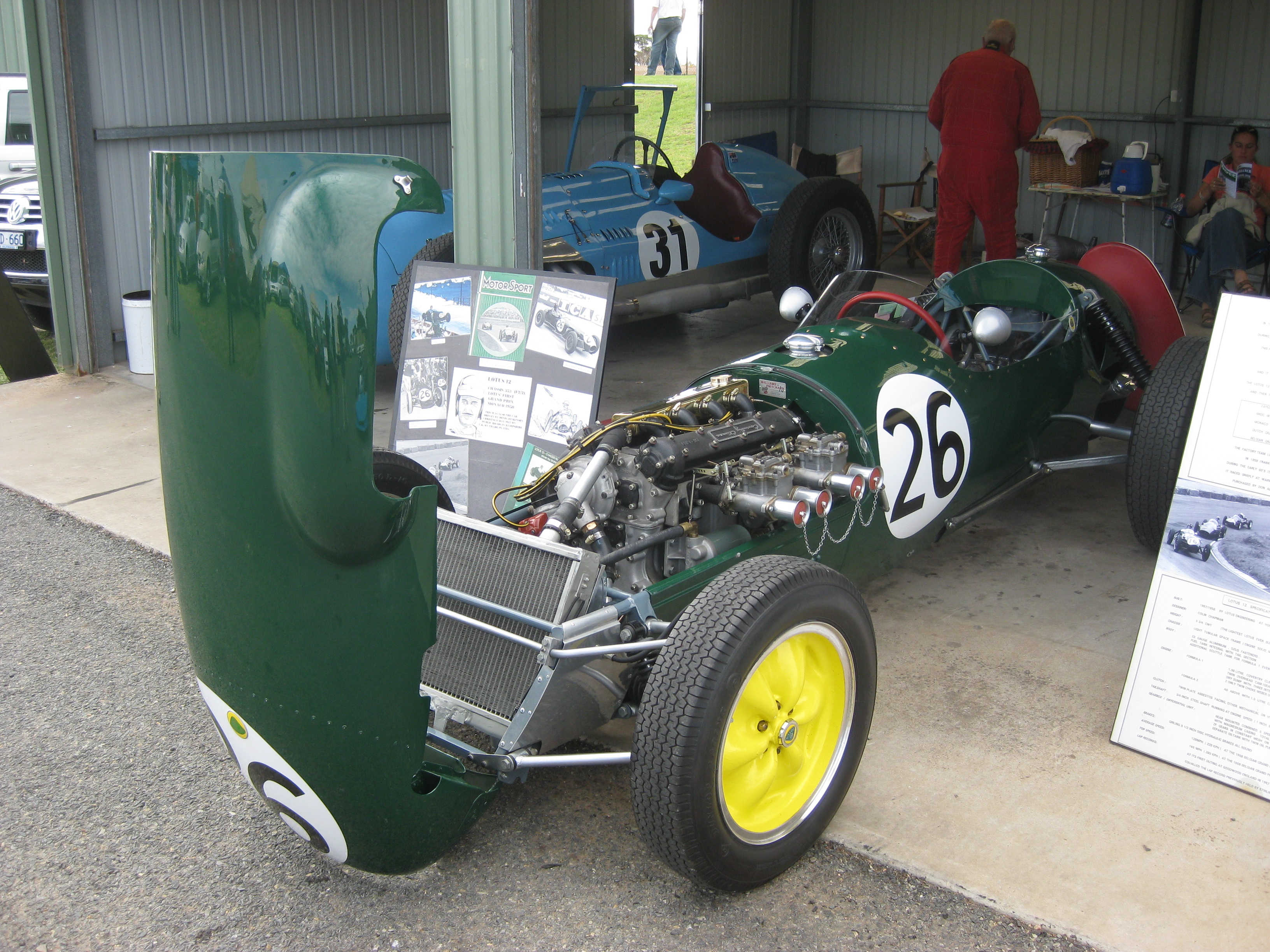|
Cooper T45
The Cooper T45 was an Open-wheel car, open-wheel formula racing car, developed and built by the Cooper Car Company in 1958, and designed by Owen Maddock. It competed in Formula 2 racing as well as in Formula One racing, where it won one World Championship Grand Prix, the 1958 Monaco Grand Prix, being driven by Maurice Trintignant. Development history and technology The Cooper T45 was the successor to the Cooper T43. The chassis remained almost unchanged, but the wheel suspension was revised. The engine was lowered. Until 1959 the cars had drum brakes, which were then replaced by disc brakes. Racing history For the Formula 1 version, Climax developed a 2.2-litre engine. Since this engine was exclusively available to the works team, Rob Walker had to resort to the 2-litre engine, which had less power. In 1958, Frenchman Maurice Trintignant surprisingly won the Monaco Grand Prix with the Walker 2-litre T45. However, the car lacked power on the fast stretches. Especially against the ... [...More Info...] [...Related Items...] OR: [Wikipedia] [Google] [Baidu] |
Cooper T45 Rob WalkerDonington Pits
Cooper, Cooper's, Coopers and similar may refer to: * Cooper (profession), a maker of wooden casks and other staved vessels Arts and entertainment * Cooper (producers), an alias of Dutch producers Klubbheads * "Cooper", a song by Roxette from the 1999 album ''Have a Nice Day (Roxette album), Have a Nice Day'' * Cooper Prize, an international playwriting prize based in Melbourne, Australia, since 2024 Businesses and organisations * Cooper (company), an American user experience design and business strategy consulting firm * Cooper (motorcycles), an American brand of motorcycles * Cooper Canada, a defunct sporting goods manufacturer * Cooper Car Company, a British car company **Mini Cooper, the name of several cars * Cooper Chemical Company, an American chemical manufacturer * The Cooper Companies, an American medical device company * Cooper Do-nuts, Los Angeles cafe which was the site of alleged uprising in reaction to police harassment of LGBT people * Cooper Enterprises, a Cana ... [...More Info...] [...Related Items...] OR: [Wikipedia] [Google] [Baidu] |
Maserati In Motorsport
Throughout its history, the Italian auto manufacturer Maserati has participated in various forms of motorsport including Formula One, sportscar racing and touring car racing, both as a works team and through private entrants. Maserati currently competes in Formula E in partnership with the Monaco Sports Group (MSG) as Maserati MSG Racing. Beginnings One of the first Maseratis the Maserati Tipo 26, Tipo 26 driven by Alfieri Maserati with Guerino Bertocchi acting as riding mechanic won the Targa Florio 1,500 cc class in 1926, finishing in ninth place in overall. Maserati was very successful in pre-war Grand Prix racing using a variety of cars with 4, 6, 8 and 16 cylinders (two straight-eights mounted parallel to one another). Other notable pre-war successes include winning the Indianapolis 500 twice (1939 and 1940), both times with Wilbur Shaw at the wheel of a 8CTF. Sports and GT cars Maserati won the Targa Florio in 1937, 1938, 1939 and 1940. The first two wins were achieved by ... [...More Info...] [...Related Items...] OR: [Wikipedia] [Google] [Baidu] |
1958 Argentine Grand Prix
The 1958 Argentine Grand Prix was a Formula One motor race held on 19 January 1958 at Autodromo Municipal Ciudad de Buenos Aires Circuit. It was race 1 of 11 in the 1958 World Championship of Drivers and race 1 of 10 in the 1958 International Cup for Formula One Manufacturers. The race was the sixth Argentine Grand Prix. It was held on the #2 variation of the circuit. The race was held over 80 laps of the four kilometre circuit for a total race distance of 313 kilometres. The race was won by British driver Stirling Moss in Rob Walker's privately entered Cooper T43. Apart from being the first World Drivers Championship race win for Cooper as a constructor it was also the first win for a rear-engined car, the first win for a car entered by a privateer team and the first win for a car powered by an engine built by another manufacturer. Moss took his seventh Grand Prix victory by 2.7 seconds over Italian driver Luigi Musso ( Ferrari 246 F1). Musso's British teammate Mike Ha ... [...More Info...] [...Related Items...] OR: [Wikipedia] [Google] [Baidu] |
Formula One Racing
Formula One race weekend refers to an auto racing event which takes place over three days (usually Friday to Sunday), with a series of practice and qualifying sessions prior to the race on Sunday. Current regulations provide for two free practice sessions on Friday, a morning practice session and an afternoon qualifying session held on Saturday, and the race held on Sunday afternoon or evening, although the structure of the weekend has changed numerous times over the history of the sport. Historically, the Monaco Grand Prix held practice on Thursday rather than Friday (up to and including ), and the whole schedule for the Las Vegas (starting from its inaugural event in ), Bahrain and Saudi Arabian Grands Prix (in only) is brought forward by one day. At most Formula One race weekends, other events such as races in other Fédération Internationale de l'Automobile (FIA) series, such as Formula 2 or Formula 3, are held. Free practice Since 2006, three free practice sessions ( ... [...More Info...] [...Related Items...] OR: [Wikipedia] [Google] [Baidu] |
Formula 2
Formula Two (F2) is a type of open-wheel formula racing category first codified in 1948. It was replaced in 1985 by Formula 3000, but revived by the FIA from 2009 to 2012 in the form of the FIA Formula Two Championship. The name returned again in 2017 when the former GP2 Series became known as the FIA Formula 2 Championship. History While Formula One has generally been regarded as the pinnacle of open-wheeled auto racing, the high-performance nature of the cars and the expense involved in the series has always meant a need for a path to reach this peak. For much of the history of Formula One, Formula Two has represented the penultimate step on the motorsport ladder. Pre-war Prior to the Second World War, there usually existed a division of racing for cars smaller and less powerful than Grand Prix racers. This category was usually called voiturette ("small car") racing and provided a means for amateur or less experienced drivers and smaller marques to prove themselves. ... [...More Info...] [...Related Items...] OR: [Wikipedia] [Google] [Baidu] |
Formula Racing
Formula racing, also known as open-wheel racing in North America, is any of several forms of open-wheeled single-seater motorsport. A "formula", first devised by FIA for its post–World War II single-seater races, is a set of regulations for a given type of car. The best known are Formula One, Formula E, Formula Two, Formula Three, regional Formula Three and Formula Four. Common usage of "formula racing" encompasses other single-seater series, including the IndyCar Series and the Super Formula Championship. Lower categories such as Formula Three and Formula Two are described as junior formulae, lower formulae, or feeder formulae, referring to their position below top-level series like Formula One on their respective career ladders of single-seater motor racing. There are two primary forms of racing formula: open formula, which allows a choice of chassis or engines; and control or "spec" formula, which specifies a single supplier for chassis and engines. Formula Three is an ... [...More Info...] [...Related Items...] OR: [Wikipedia] [Google] [Baidu] |
Open-wheel Car
An open-wheel car is a car with the wheels outside the car's main body, and usually having only one seat. Open-wheel cars contrast with street cars, Sports car racing, sports cars, Stock car racing, stock cars, and Touring car racing, touring cars, which have their wheels below the body or inside Fender (vehicle), fenders. Open-wheel cars are built both for road racing and oval track racing. Open-wheel cars licensed for use on public roads (Street-legal vehicle, street legal), such as the Ariel Atom, are uncommon, as they are often impractical for everyday use. History American racecar driver and constructor Ray Harroun was an early pioneer of the concept of a lightweight single-seater, open-wheel "monoposto" racecar. After working as a mechanic in the automotive industry, Harroun began competitive professional racing in 1906, winning the AAA National Championship in 1910. He was then hired by the Marmon Motor Car Company as chief engineer, charged with building a racecar intended ... [...More Info...] [...Related Items...] OR: [Wikipedia] [Google] [Baidu] |
1958 Monaco Grand Prix
The 1958 Monaco Grand Prix was a Formula One motor race held on 18 May 1958 at Circuit de Monaco, Monaco. It was race 2 of 11 in the 1958 World Championship of Drivers and race 2 of 10 in the 1958 International Cup for Formula One Manufacturers. The race was the 16th Monaco Grand Prix and was held over 100 laps of the three kilometre circuit for a total race distance of 314 kilometres. The race was won by French driver Maurice Trintignant in the second and final Grand Prix victory of his long career. The win was the second consecutive victory for the privateer Rob Walker Racing Team. Trintignant took the teams newly acquired Cooper T45 to a twenty-second victory over Italian driver Luigi Musso driving a Ferrari 246 F1 with Musso's British teammate Peter Collins (racing driver), Peter Collins (Ferrari 246 F1) was third. Trintignant's win put the superiority of front-engined cars in doubt. Musso's second place put him into a four-point championship lead over Moss and Trintignant. ... [...More Info...] [...Related Items...] OR: [Wikipedia] [Google] [Baidu] |





